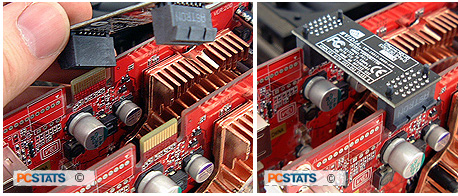nVidia is currently in a
position to do something it has not done in a while, and that is dominate a
portion of the lucrative mainstream videocard market. The release of its
nForce 4 SLI motherboard chipset, coupled with the impressive
mid-range performance and effective pricing of their Geforce 6600 and 6600
GT video processors have put nVidia in a position where
its products are providing better value for the money than the
competition.
The Geforce 6600/6600GT GPU, like its
opposite the ATI X700/X700 PRO, offers considerably more for the money
than the mainstream cards of previous generations did. While this mainstream nVIDIA GPU only has half the
rendering pipelines of its high end counterpart the 6800GT/Ultra, let's remember
something; the NV43 still has eight pixel rendering pipelines.
This is the same number as the ATI Radeon 9800XT, and twice that of the
GeForceFX 5950 Ultra. Both of those cards still perform well in today's tests,
meaning that the 6600 GPU is off to a good start.
Today
PCstats is testing out nine Geforce 6600 and Geforce 6600 GT based videocards, in both AGP
and PCI Express versions. The features of each videocard will be compared,
as well as the standard run of gaming benchmarks. SLI benchmarks will
be analyzed wherever possible with the overall aim of deciding which
of the mainstream graphics cards solutions in this roundup provides the best
value for money, whether you are looking for a single mid-range gaming card
or a dual-videocard SLI powerhouse.
The nVidia
GeForce 6600/6600GT (NV43) core is
built on IBM's 0.11 micron manufacturing process and contains 146 million transistors. nVIDIA has cut
the number of vertex pipelines from the six found in the
GeForce 6800 class cards to three, as we mentioned.
To economize further, the memory controller has also been dropped to 128-bit. At
high resolutions with AA/AF enabled, Geforce 6600GT cards cannot handle
the load as well as their more expensive siblings, but past reviews
have shown that 6600-based cards do scale better.
There are two flavours of the NV43 core, the GeForce 6600 and
its higher-end sibling, the Geforce 6600GT. Most 'vanilla' Geforce 6600-based cards run at 300 MHz
core / 500 MHz memory, while most 6600GT's are clocked a little higher;
500MHz core and 1000MHz memory. All nVidia Geforce 6600-based cards support DirectX 9.0C effects
as well as nVIDIA's Shader Model 3.0. More importantly, the 6600GT and some
6600 cards also support SLI.
Now let's take a close look at each of our contenders in some detail, before
getting into the benchmarks.
 |
|
The Geforce 6600/GT Videocards |
|
|
|
| |
*As this card uses two GPUs onboard, it is not externally SLI compatible
**This card has an SLI connector, though 6600GPUs are not
officially SLI compatible.
***Price includes Gigabyte
K8NXP-SLI motherboard
Geforce 6600GT and
SLI
nVidia's new SLI (Scaleable Link Interface) technology
is used to link two PCI Express nVidia-based cards together, splitting the
rendering load between them to increase 3D performance. The technology requires
a pair of compatible PCI Express x16 videocards with SLI connectors (which must
be implemented by the video card manufacturer) and
an Nforce 4 SLI chipset-based motherboard.
The nVidia Nforce 4 SLI solution provides two physical
PCI Express x16 video slots, and uses a switch to divert 8 PCI Express data
lanes to serve each slot.  A single card can
also be used in either slot, and in this case the full 16 PCI Express lanes are
available. In a typical SLI solution, the cards themselves are also linked by
way of an SLI bridge or cable attached to the special MIO 'video bus' connector
on the top of each card.
A single card can
also be used in either slot, and in this case the full 16 PCI Express lanes are
available. In a typical SLI solution, the cards themselves are also linked by
way of an SLI bridge or cable attached to the special MIO 'video bus' connector
on the top of each card.
Nvidia's SLI works by allowing the two graphical
processors to share the rendering workload, governed by the Nvidia Detonator
software drivers. The CPU passes all neccessary 3D information to the 'primary'
GPU, which then shares the information with the second card via the video bus
interface cable. The video bus link itself apparently runs at up to 10GB/s,
though we doubt that this bandwidth is fully utilized.
Currently, the only official nVidia SLI-compatible video
processors are the Geforce 6600GT, 6800, 6800GT and 6800 Ultra, though we have
reviewed 6600-based cards that also had the connector. The graphical processors
in each video card must be identical, as must the video BIOS revisions, though
the cards can run at separate speeds (the SLI system will assume the lowest
clock speeds for both cards). This means that it is going to be pretty much
essential to have two identical cards from the same manufacturer to get SLI
working correctly.

